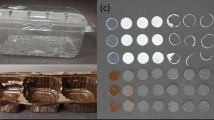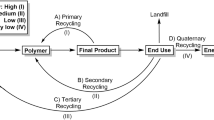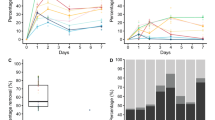Abstract
Phthalic acid esters (PAEs) are human made chemicals widely used as plasticizers to enhance the flexibility of plastic products. Due to the lack of chemical bonding between phthalates and plastics, these materials can easily enter the environment. Deleterious effects caused by this chemo-pollutant have drawn the attention of the scientific community to remediate them from different ecosystem. In this context, many bacterial strains have been reported across different habitats and Sphingobium yanoikuyae strain P4 is among the few psychrotolerant bacterial species reported to biodegrade simple and complex phthalates. In the present study, biodegradation of three structurally different PAEs viz., diethyl phthalate (DEP), di-isobutyl phthalate (DIBP), and butyl benzyl phthalate (BBP) have been investigated by the strain P4. Quantitative analyses through High-performance liquid chromatography (HPLC) revealed that the bacterium completely degraded 1 g/L of DEP, DIBP, and BBP supplemented individually in minimal media pH 7.0 within 72, 54, and 120 h of incubation, respectively, at 28 °C and under shake culture condition (180 rpm). In addition, the strain could grow in minimal media supplemented individually with up to 3 g/L of DEP and 10.0 g/L of DIBP and BBP at 28 °C and pH 7.0. The strain also could grow in metabolites resulting from biodegradation of DEP, DIBP, and BBP, viz. n-butanol, isobutanol, butyric acid, ethanol, benzyl alcohol, benzoic acid, phthalic acid, and protocatechuic acid. Furthermore, phthalic acid and protocatechuic acid were also detected as degradation pathway metabolites of DEP and DIBP by HPLC, which gave an initial idea about the biodegradation pathway(s) of these phthalates.






Similar content being viewed by others
Data availability
The datasets generated during and/or analysed during the current study are available from the corresponding author on reasonable request.
References
Agas D, Sabbieti MG, Capacchietti M, Materazzi S, Menghi G, Materazzi G, Hurley MM, Marchetti L (2007) Benzyl butyl phthalate influences actin distribution and cell proliferation in rat py1a osteoblasts. J Cellular Biochem 101:543–551. https://doi.org/10.1002/jcb.21212
Ahmad R, Gautam AK, Verma Y, Sedha S, Kumar S (2014) Effects of in utero di-butyl phthalate and butyl benzyl phthalate exposure on offspring development and male reproduction of rat. Environ Sci Poll Res 21:3156–3165. https://doi.org/10.1007/s11356-013-2281-x
Benson R (2009) Hazard to the developing male reproductive system from cumulative exposure to phthalate esters—dibutyl phthalate, diisobutyl phthalate, butylbenzyl phthalate, diethylhexyl phthalate, dipentyl phthalate, and diisononyl phthalate. Regul Toxicol Pharmacol 53(2):90–101. https://doi.org/10.1016/j.yrtph.2008.11.005
Cao H, Wei D, Yang Y, Shang Y, Li G, Zhou Y, Ma Q, Xu Y (2017) Systems-level understanding of ethanol-induced stresses and adaptation in E. coli. Sci Rep 7:44150. https://doi.org/10.1038/srep44150
Chatterjee S, Dutta TK (2003) Metabolism of butyl benzyl phthalate by Gordonia sp. strain MTCC 4818. Biochem Biophys Res Commun 309:36–43. https://doi.org/10.1016/S0006-291X(03)01513-4
Chatterjee S, Dutta TK (2008a) Complete degradation of butyl benzyl phthalate by a defined bacterial consortium: role of individual isolates in the assimilation pathway. Chemosphere 70:933–941. https://doi.org/10.1016/j.chemosphere.2007.06.058
Chatterjee S, Dutta TK (2008b) Metabolic cooperation of Gordonia sp. strain MTCC 4818 and Arthrobacter sp. strain WY in the utilization of butyl benzyl phthalate: effect of a novel co-culture in the degradation of a mixture of phthalates. Microbiology 154:3338–3346. https://doi.org/10.1099/mic.0.2008/021881-0
Chatterjee S, Karlovsky P (2010) Removal of the endocrine disrupter butyl benzyl phthalate from the environment. Appl Microbiol Biotechnol 87:61–73. https://doi.org/10.1007/s00253-010-2570-y
Chatterjee S, Mallick S, Dutta TK (2005) Pathways in the degradation of hydrolyzed alcohols of butyl benzyl phthalate in metabolically diverse Gordonia sp. strain MTCC 4818. J Mol Microbiol Biotechnol 9:110–120. https://doi.org/10.1159/000088841
Chaudhary G, Jasrotia A, Raj P, Kaur R, Kumari A, Rajput VD, Minkina T, Mandzhieva S, Kaur R (2023) Contamination of water and sediments of harike wetland with phthalate esters and associated risk assessment. Water 15(6):1009. https://doi.org/10.3390/w15061009
Chauret C, Mayfield CI, Inniss WE (1995) Biotransformation of di-n-butyl phthalate by psychrotrophicPseudomonas fluoresceins (BGW) isolated from subsurface environment. Can J Microbio 41:54–63. https://doi.org/10.1139/m95-007
Das MT, Kumar SS, Ghosh P, Shah G, Malyan SK, Bajar S, Thakur IS, Singh L (2021) Remediation strategies for mitigation of phthalate pollution: challenges and future perspectives. J Hazard Mater 409:124496. https://doi.org/10.1016/j.jhazmat.2020.124496
Ding J, Wang C, Xie Z, Li J, Yang Y, Mu Y, Tang X, Xu B, Zhou J, Huang Z (2015) Properties of a newly identified esterase from Bacillussp. K91 and its novel function in diisobutyl phthalate degradation. PLoS ONE 10(3):e0119216. https://doi.org/10.1371/journal.pone.0119216
Ejlertsson J, Svensson BH (1997) Degradation of bis(2-ethylhexyl)phthalate constituents under methanogenic conditions. Biodegradation 7(6):501–506. https://doi.org/10.1007/BF00115296
Epa US (1991) National Primary Drinking Water Regulations, Federal Register, 40 CFR, Part 141. US Environmental Protection Agency, Washington, DC ((Chapter 1))
Feng L, Liu H, Cheng D, Mao X, Wang Y, Wu Z, Wu Q (2018) Characterization and genome analysis of a phthalate esters degrading strain Sphingobium yanoikuyae SHJ. Biomed Res Int 2018:3917054. https://doi.org/10.1155/2018/3917054
Fromme H, Gruber L, Seckin E, Raab U, Zimmermann S, Kiranoglu M, Schlummer M, Schwegler U, Smolic S, VölkelHBMnet W (2011) Phthalates and their metabolites in breast milk–results from the Bavarian Monitoring of Breast Milk (BAMBI). Environ Int 37:715–722. https://doi.org/10.1016/j.envint.2011.02.008
Grindler NM, Vanderlinden L, Karthikraj R, KannanK TS, Polotsky AJ, Powell TL, Yang IV, Jansson T (2018) Exposure to phthalate, an endocrine disrupting chemical, alters the first trimester placental methylome and transcriptome in women. Sci Rep 8:6086. https://doi.org/10.1038/s41598-018-24505-w
Hou H, Min Y, Liu X, Wang P, Zhou Z, Liu D (2021) Occurrence and migration of phthalates in adhesive materials to fruits and vegetables. J Hazard Mater 418:126277. https://doi.org/10.1016/j.jhazmat.2021.126277
Hu T, Yang C, Hou Z, Liu T, Mei X, Zheng L, Zhong W (2022) Phthalate esters metabolic strain Gordonia sp. GZ-YC7 a potential soil degrader for high concentration Di-(2-ethylhexyl) phthalate. Microorganisms. 10(3):641. https://doi.org/10.3390/microorganisms10030641
Huang H, Zhang XY, Chen TL, Zhao YL, Xu DS, Bai YP (2019) Biodegradation of structurally diverse phthalate esters by a newly identified esterase with catalytic activity toward Di(2-ethylhexyl) phthalate. J Agric Food Chem 67:8548–8558. https://doi.org/10.1021/acs.jafc.9b02655
Jackson M, Labeda D, Becker L (1996) Isolation for bacteria and fungi for thehydrolysis of phthalate and terephthalate esters. Journalof Industrial Microbiology 16(5):301–304. https://doi.org/10.1007/BF01570038
Jin D, Kong X, Cui B, Bai Z, Zhang H (2013) Biodegradation of di-n-butyl phthalate by a newly isolated halotolerant Sphingobium sp. Int J MolSci 14(12):24046–24054. https://doi.org/10.3390/ijms141224046
Karegoudar TB, Pujar BG (1984) Metabolism of diethylphthalate by a soil bacterium. Curr Microbiol 11(6):321–324. https://doi.org/10.1007/BF01567699
Katsikantami I, Sifakis S, Tzatzarakis MN, Vakonaki E, Kalantzi O, Tsatsakis AM, Rizos AK (2016) A global assessment of phthalates burden and related links to health effects. Environ Int 97:212–236. https://doi.org/10.1016/j.envint.2016.09.013
Kay VR, Chambers C, Foster WG (2013) Reproductive and developmental effects of phthalate diesters in females. Crit Rev Toxicol 43(3):200–219. https://doi.org/10.3109/10408444.2013.766149
Khadka S, Nshimiyimana JB, Zou P, Koirala N, Li X (2020) Biodegradation kinetics of diethyl phthalate by three newly isolated strains of Pseudomonas. Scientific African 8:e00380. https://doi.org/10.1016/j.sciaf.2020.e00380
Koniecki D, Wang R, Moody RP, Zhu J (2011) Phthalates in cosmetic and personal care products: concentrations and possible dermal exposure. Environ Res 111(3):329–336. https://doi.org/10.1016/j.envres.2011.01.013
Latini G, Wittassek M, Del Vecchio A, Presta G, De Felice C, Angerer J (2009) Lactational exposure to phthalates in southern Italy. Environ Int 35:236–239. https://doi.org/10.1016/j.envint.2008.06.002
Lee H, Lee J, Choi K, Kim KT (2019) Comparative analysis of endocrine disrupting effects of major phthalates in employed two cell lines (MVLN and H295R) and embryonic zebrafish assay. Environ Res 172:319–325. https://doi.org/10.1016/j.envres.2019.02.033
Liang DW, Zhang T, Fang HHP, He J (2008) Phthalates biodegradation in the environment. Appl Microbiol Biotechnol 80:183–198. https://doi.org/10.1007/s00253-008-1548-5
Lu Y, Tang F, Wang Y, Zhao JH, Zeng X, LuoQF WL (2009) Biodegradation of dimethyl phthalate, diethyl phthalate and di-n-butyl phthalate by Rhodococcussp L4 isolated from activated sludge. J Hazard Mater 168(2–3):938–943. https://doi.org/10.1016/j.jhazmat.2009.02.126
Mahajan R, Verma S, Kushwaha M, Singh D, Akhter Y, Chatterjee S (2019) Biodegradation of di-n-butyl phthalate by psychrotolerant Sphingobium yanoikuyae strain P4 and protein structural analysis of carboxylesterase involved in the pathway. Internat J Biol Macromol 122:806–816. https://doi.org/10.1016/j.ijbiomac.2018.10.225
Moral R, Santucci-Pereira J, Wang R, Russo IH, Lamartiniere CA, Russo J (2011) In utero exposure to butyl benzyl phthalate induces modifications in the morphology and the gene expression profile of the mammary gland: an experimental study in rats. Environ Health 10(1):5. https://doi.org/10.1186/1476-069X-10-5
Navacharoen A, Vangnai AS (2011) Biodegradation of diethyl phthalate by an organic-solvent-tolerant Bacillussubtilis strain 3C3 and effect of phthalate ester coexistence. Intern Biodeter Biodeg 65:818–826. https://doi.org/10.1016/j.ibiod.2011.05.005
NishiokaT IM, Imaoka T, Mutoh M, Egashira Y, Nishiyama T, Shin T, Fujii T (2006) A mono-2-ethylhexyl phthalate hydrolase from aGordoniasp. that is able to dissimilate di-2-ethylhexyl phthalate. Appl Environ Microbiol 72:2394–2399. https://doi.org/10.1128/AEM.72.4.2394-2399.2006
Olkowska E (2023) Permeability of Dimethyl Phthalate Through Human Skin Models – Health Risk Assessment. Expo Health. https://doi.org/10.1007/s12403-023-00558-9
Ovchinnikov DV, Falev DI, Solovyova PV, Ul’yanovskii NV, Kosyakov DS (2022) Rapid determination of phthalates in paper products by supercritical fluid chromatography/tandem mass spectrometry. J Separat Sci 45(11):4116–4127. https://doi.org/10.1002/jssc.202200404
Peijnenburg WJGM (2008) Phthalates SE Jørgensen BD Fath. Encyclopedia of Ecology Academic Press 2733:2738. https://doi.org/10.1016/B978-008045405-4.00419-5
Ren L, Jia Y, Ruth N, Qiao C, Wang J, Zhao B, Yan Y (2016) Biodegradation of phthalic acid esters by a newly isolated Mycobacterium sp. YC-RL4 and the bioprocess with environmental samples. Environ Sci Pollut R 23(16):16609–16619. https://doi.org/10.1007/s11356-016-6829-4
Ren L, Lin Z, Liu H, Hu H (2018) Bacteria-mediated phthalic acid esters degradation and related molecular mechanisms. Appl Microbiol Biotech 102:1085–1096. https://doi.org/10.1007/s00253-017-8687-5
Sarkar J, Chowdhury PP, Dutta TK (2013) Complete degradation of di-n-octyl phthalate by Gordonia sp. strain Dop5. Chemosphere 90(10):2571–2577. https://doi.org/10.1016/j.chemosphere.2012.10.101
Shariati S, Pourbabaee AA, Alikhani HA, Rezaei KA (2019) Assessment of phthalic acid esters pollution in Anzali wetland, north of Iran. Intern J Environ Sci Technol 16(11):7025–7036. https://doi.org/10.1007/s13762-018-2110-3
Shariati S, Pourbabaee AA, Alikhani HA (2023) Biodegradation of diethyl phthalate and phthalic acid by a new indigenous Pseudomonas putida. Folia Microbiol 68:477–488. https://doi.org/10.1007/s12223-022-01022-y
Sree CG, Buddolla V, Lakshmi BA, Kim YJ (2023) Phthalate toxicity mechanisms: An update. Comp Biochem Physiol C: Toxicol Pharmacol 263:109498. https://doi.org/10.1016/j.cbpc.2022.109498
Szewczyńska M, Pośniak M, Dobrzyńska E (2020) Determination of phthalates in particulate matter and gaseous phase emitted into the air of the working environment. Int J Environ Sci Technol 17:175–186. https://doi.org/10.1007/s13762-019-02435-y
Tang WJ, Zhang LS, Fang Y, Zhou Y, Ye BC (2016) Biodegradation of phthalate esters by newly isolated Rhizobium sp. LMB-1 and its biochemical pathway of di-n-butyl phthalate. J Appl Microbiol 121(1):177–186. https://doi.org/10.1111/jam.13123
Tekin K, Arslan P, Cil B, Filazi A, Akçay E, Yurdakok-Dikmen B (2020) Companion animals get close to the toxic aspects of antropogenic world: cytotoxicity of phthalates and bisphenol A on dog testicular primary cells. Cytotechnology 72(5):629–638. https://doi.org/10.1007/s10616-020-00401-y
Tran CM, Do TN, Kim KT (2021) Comparative analysis of neurotoxicity of six phthalates in zebrafish embryos. Toxics 9:5. https://doi.org/10.3390/toxics9010005
Tumu K, Vorst K, Curtzwiler G (2023) Endocrine modulatingchemicals in food packaging: A review ofphthalates and bisphenols. Comprehensive Reviews in Food Science and Food Safety 22:1337–1359. https://doi.org/10.1111/1541-4337.13113
Union E (1993) Council Regulation (EEC), No 793/93 of 23 March 1993 on the Evaluation and Control of the Risks of Existing Substances (OJ L84, 5 April 1993). European Union, Brussels
Wang Y, Liu H, Peng Y, Tong L, Feng L, Ma K (2018) New pathways for the biodegradation of diethyl phthalate by Sphingobium yanoikuyae SHJ. Process Biochem 71:152–158. https://doi.org/10.1016/j.procbio.2018.05.010
Wittassek M, Wiesmuller GA, Koch HM, Eckard R, Dobler L, Muller J, Angerer J, Schlüter C (2007) Internal phthalate exposure over the last two decades–a retrospective human biomonitoring study. Int J Hyg Environ Health 210:319–333. https://doi.org/10.1016/j.ijheh.2007.01.037
Wittassek M, Angerer J, Kolossa-Gehring M, Schafer SD, Klockenbusch W, Dobler L, Günsel AK, Müller A, Wiesmüller GA (2009) Fetal exposure to phthalates-a pilot study. Int J Hyg Environ Health 212:492–498. https://doi.org/10.1016/j.ijheh.2009.04.001
Wu Q, Liu H, Zhang D, Shi X (2010) Effect of di-n-butyl phthalate (DBP) on the microbial diversity in shallow aquifer sediment, China. Environmental Science 30(5):671–676
Xu XR, Li HB, Gu JD (2005) Biodegradation of an endocrine-disrupting chemical di-n-butyl phthalate ester by Pseudomonas fluorescens B-1. Intern Biodeter Biodegrad 55:9–15. https://doi.org/10.1016/j.ibiod.2004.05.005
Xu XR, Li HB, Gu JD (2006) Elucidation ofn-butyl benzyl phthalatebiodegradation using high-performance liquid chromatographyand gas chromatography–mass spectrometry. Anal Bioanal Chem 386:370–375. https://doi.org/10.1007/s00216-006-0627-7
Xu WJ, Wan Q, Wang WF, Wang Y, Fy F, Cheng JJ, Yuan JJ, Yu XY (2020a) Biodegradation of di-butyl phthalate by a novel endophytic Bacillus subtilis strain HB-T2 under in-vitro and in-vivo conditions. Environ Technol 43(13):1917–1926. https://doi.org/10.1080/09593330.2020.1858181
Xu Y, Minhazul KAHM, Wang X, Liu X, Li X, Meng Q, Li H, Zhang C, Sun X, Sun B (2020b) Biodegradation of phthalate esters by Paracoccuskondratievae BJQ0001 isolated from Jiuqu (Baijiu fermentation starter) and identification of the ester bond hydrolysis enzyme. Environ Pollut 263(Pt B):114506. https://doi.org/10.1016/j.envpol.2020.114506
Yang X, ZhangC HeZ, HuX GuoJ, ZhongQ WangJ, XiongL LiuD (2013) Isolation and characterization of two n-butyl benzyl phthalate degrading bacteria. Intern Biodeter Biodegrad 76:8–11. https://doi.org/10.1016/j.ibiod.2012.06.005
Yost EE, Euling SY, Weaver JA, Beverly BEJ, Keshava N, Mudipalli A, Arzuaga X, Blessinger T, Dishaw L, Hotchkiss A, Makris SL (2019) Hazards of di-isobutyl phthalate (DIBP) exposure: A systematic review of animal toxicology studies. Environ Intern 125:579–594. https://doi.org/10.1016/j.envint.2018.09.038
Zhang Y, Chen H, Jiamei L, Ge G, Deli L, Hui G, Li X (2018) Genome sequencing and biodegradation characteristics of the n-butyl benzyl phthalate degrading bacterium-Rhodococcus sp. HS-D2. Intern Biodeter Biodegrad 128:56–62. https://doi.org/10.1016/j.ibiod.2016.08.024
Zhang H, Li J, Ma T, Ma K, Ni X, Wu S (2023) Accumulation and Transport of Phthalic Acid Esters in the Soil-Plant System of Agricultural Fields with Different Years of Film Mulching. Sustainability 15(21):15589. https://doi.org/10.3390/su152115589
Zota AR, Calafat AM, Woodruff TJ (2014) Temporal trends in phthalate exposures:findings from the National Health and Nutrition Examination Survey, 2001–2010. Environ Health Perspect 122:235–241. https://doi.org/10.1289/ehp.1306681
The Times of India 2020 Toxic chemicals in baby diapers a huge risk: Study. https://timesofindia.indiatimes.com/city/delhi/toxic-chemicals-in-baby-diapers-a-huge-risk-study/articleshow/78373966.cms?from=mdr
US EPA (US Environmental Protection Agency)(2017) Chemical Data Reporting (2012 and 2016 Public CDR database). US Environmental Protection Agency, Office of Pollution Prevention and Toxics. https://www.epa.gov/chemical-data-reporting. HERO ID: 6275311
US EPA (US Environmental Protection Agency) 2023 Risk Evaluation for Butyl Benzyl Phthalate - 1,2-Benzene- dicarboxylic acid, 1- butyl 2(phenylmethyl) ester.https://www.epa.gov/assessing-and-managing-chemicals-under-tsca/risk-evaluation-butyl-benzyl-phthalate-12-benzene
Acknowledgements
MK gratefully acknowledges UGC for fellowship, the Central University of Himachal Pradesh, HP, India, and CSIR-Institute of Himalayan Bioresource Technology, Palampur, HP, India, for providing laboratory facilities and financial assistance.
Funding
The authors declare that no funds, grants, or other support were received for this work.
Author information
Authors and Affiliations
Contributions
MK: Performed the experiments, and data analysis, and contributed to manuscript writing. DS: Review & editing, YA: Review & editing, Subhankar Chatterjee: Conceptualization, Writing - review & editing and overall supervision of the work. All authors reviewed the manuscript.
Corresponding author
Ethics declarations
Conflict of interest
The authors declare that they have no known competing financial interests or personal relationships that could have appeared to influence the work reported in this paper. One of the authors is the Editor-in-Chief of the journal, however, he has no role in editorial or peer review of this submission.
Additional information
Communicated by PANKAJ BHATT.
Publisher's Note
Springer Nature remains neutral with regard to jurisdictional claims in published maps and institutional affiliations.
Supplementary Information
Below is the link to the electronic supplementary material.
Rights and permissions
Springer Nature or its licensor (e.g. a society or other partner) holds exclusive rights to this article under a publishing agreement with the author(s) or other rightsholder(s); author self-archiving of the accepted manuscript version of this article is solely governed by the terms of such publishing agreement and applicable law.
About this article
Cite this article
Kushwaha, M., Singh, D., Akhter, Y. et al. Biodegradation of DEP, DIBP, and BBP by a psychrotolerant Sphingobium yanoikuyae strain P4: Degradation potentiality and mechanism study. Arch Microbiol 206, 254 (2024). https://doi.org/10.1007/s00203-024-03977-7
Received:
Revised:
Accepted:
Published:
DOI: https://doi.org/10.1007/s00203-024-03977-7




